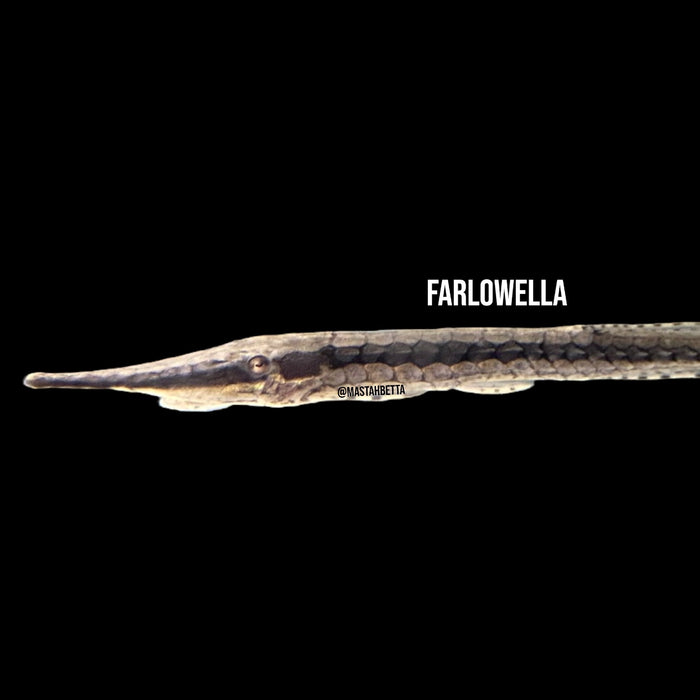
Farlowella
Farlowella for sale Online
Farlowella for sale Hawaii
Farlowella for sale near me

Farlowella for sale Online
Farlowella for sale Hawaii
Farlowella for sale near me
Name: Farlowella Catfish (Farlowella spp.)
Max Size: Farlowella Catfish are a group of fish species that vary in size depending on the specific species. Most Farlowella species can grow up to 5-7 inches in length.
Recommend pH: Farlowella Catfish prefer slightly acidic to neutral water conditions with a recommended pH range of 6.5-7.5.
Recommended Temperature (°F): Maintain the aquarium temperature for Farlowella Catfish between 73-79°F (23-26°C), providing a stable and tropical environment.
Diet: Farlowella Catfish are herbivores and mainly eat algae and plant matter. In the aquarium, they will graze on algae-covered surfaces and accept algae-based sinking pellets or wafers. Supplement their diet with blanched vegetables like zucchini or spinach.
Temperament: Farlowella Catfish are peaceful and non-aggressive. They are generally shy and prefer to hide during the day, becoming more active during the night. Provide them with plenty of hiding spots in the aquarium.
Schooling or Non-Schooling Fish: Farlowella Catfish are non-schooling fish. They are generally solitary in nature, but you can keep them in small groups if your aquarium is large enough to accommodate their needs.
Possible Types of Tank Mates: Farlowella Catfish can be kept with other peaceful community fish that are not aggressive or fin-nippers. They coexist well with tetras, rasboras, peaceful cichlids, and other non-aggressive catfish species.
Behavior: Farlowella Catfish are known for their unique appearance with their long, slender bodies and twig-like appearance, which helps them blend into their natural environment. They are skilled algae eaters and will move slowly along surfaces to graze on algae. Their elongated mouth and snout allow them to reach algae in hard-to-reach places.
Fun Fact: Farlowella Catfish are often referred to as "twig catfish" or "vampire catfish" due to their elongated and twig-like appearance. Their ability to mimic twigs helps them avoid predators in the wild by camouflaging into their surroundings. This adaptation makes them fascinating and intriguing additions to aquariums, especially for aquarists who appreciate unique and cryptic fish species.
Perhaps the best store on island to get freshwater fish. They have a huge variety, including higher end freshwater fish (discus, puffers, flowerhorns , oddballs, ect) I’ve stocked a few tanks with their fish. They quarantine well and keep it real on how their fish are doing in shop.
Mr. Ali
Had a great experience here. I was looking for a unicorn/alicorn betta and spoke with the owner, Josh, about it. I ended up using his fish importing services to import a fish from Jakarta, and he brought in a few more white opaque or unicorn type half moon bettas too, to add to the variety in store. I got a sneak peak of the store while it was shut down for one week for a proper quarantine of its new fish. The owner knows his fish and keeps them healthy. A very different experience from a Petco or PetSmart! A Petco employee even recommended I go here for more unique betta fish. Note that they carry other types of fish too, plus Aquatic plants and some aquarium equipment. Pictured are some of the giant bettas, the alicorn betta, and i believe a beautiful ram.
Fawn B.
Wonderful shop with lots of variety. Has the most unique selection of fish on the island, and at a reasonable price! Staff is friendly and very helpful when we have questions or concerns. Love coming here and seeing the jokes around the store. Also, Vinnie!
Ian H.
The owner, Josh, is not just knowledgeable about the fish, but also plants and tank issues. I am new to fish tanks and he has been extremely helpful in answering my questions and offering suggestions to make my experience easier. Parking is a bit tricky, but certainly worth it.
Mark M.
They have rare plants you can't find at most places. Got lucky we got a few; my husband is happy. This is one of his favorite places. They get pretty busy, so be patient. The staff are very helpful.
Mr. Chin
Our online catalog is stocked with a wide variety of fresh water fish and Plants!
{"one"=>"Select 2 or 3 items to compare", "other"=>"{{ count }} of 3 items selected"}